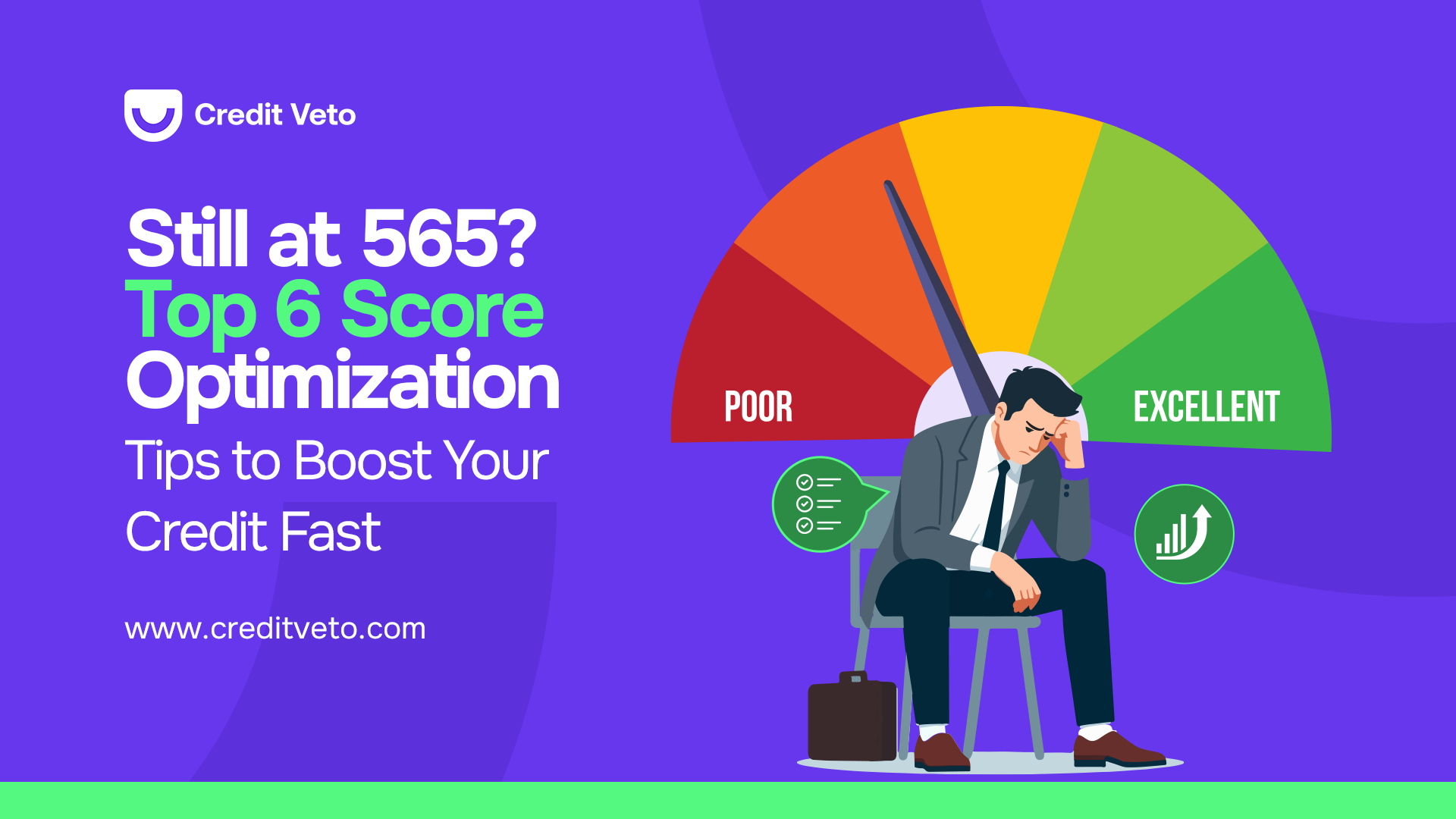Still at 565? Top 6 Score Optimization Tips to Boost Your Credit Fast
Struggling to raise your credit score from 565, 675, or 680? Discover real reasons why it isn’t improving and how to go from 565 to 700+ with these top 6 strategies that work.

You’re doing everything you think is right: paying off debt, trying not to use too much credit, and even reading up on score optimization tips, but your score still won’t budge.
Whether you’re sitting at a 565 credit score or stuck in the high 600s wondering if 680 is a good credit score (it’s fair, but you can do better), you’re not alone. Many people face this exact frustration.
In this post, we’ll walk through the most common reasons your score might be stuck and how to fix them using everyday strategies. If you’ve asked questions like, "Is 675 a good credit score?" or "Why hasn’t my score improved even after paying bills?", this is for you.
What Does a 565 Credit Score Really Mean?
If your credit score is sitting at 565, you’re not alone, and you’re not stuck either. A 565 credit score falls into the “poor” category, which can make it tough to qualify for loans, secure low-interest rates, or even get approved for an apartment. But here’s the good news: it’s not permanent.
Many people assume you need to jump straight to a 700+ score to see results, but even small improvements can make a difference. Moving from a 565 to a 675 credit score or even hitting a solid 680 credit score can change the game completely. You’ll start to see better loan terms, more approval chances, and less financial stress.
The key is knowing what steps actually help. That’s where score optimization tips come in. If you’ve been asking questions like “Is 675 a good credit score?” or “How long will it take to improve my score?” This next section breaks down exactly what you need to do to see fast, meaningful results.
Now let’s get into the top 6 credit score optimization tips that can help you move from stuck to soaring.
Read More: Everything You Need to Know About Your Credit Score and How It Affects You
1. You Haven’t Looked Deep Enough Into Your Credit Report
Knowing your credit score isn’t enough. A 565 credit score or even a 680 credit score doesn’t tell you why your score is where it is. The real answers live inside your full credit report, where the fine print reveals the story behind the numbers.
Why It Matters:
You could be doing everything right, like paying down debt and making payments on time, but still feel stuck. That’s often because outdated accounts, inaccurate late payments, or old collections are quietly weighing you down. Even if your goal is to move from a 675 to a 700+ score, these hidden issues can block progress.
Many people often ask, “Is 675 a good credit score?” Yes, it’s decent, but cleaning up your report could push you higher, faster.
What to Do:
Start by pulling your full credit report from all three major bureaus. Don’t just glance; dig deep. Look for duplicate entries, errors in payment history, or debts you’ve already cleared but are still showing as unpaid. That one inaccurate delinquent item might be the reason your 565 credit score isn’t moving.
With tools like Credit Veto, you can identify these issues and dispute them legitimately. It’s one of the most effective score optimization tips you’ll ever use. Fixing your foundation is how real credit improvement starts.
See Also: Is Your Payment History Hurting Your Credit? Here's How to Improve It and Raise Your Score
2. Late Payments and High Utilization Are Quietly Holding You Back
You might still be thinking, “Is 675 a good credit score?” Well, it’s not bad, but it could be better. One late payment or high usage on your cards might be what’s keeping you from crossing into the 700s. And yes, even a single slip can linger on your credit report for years.
Why It Matters:
Whether your score sits at 680 or you’re trying to climb from a 565 credit score, late payments and high utilization tell lenders one thing: risk. In fact, just one 30-day late payment can knock off anywhere between 50 and 100 points. And your score won’t wait for you to explain; you’ll feel the drop almost instantly.
If your credit cards are nearly maxed out, that’s another silent killer. A high utilization rate can drag your score even when you’re making payments consistently.
What to Do:
Automate your payments—at least the minimums—so you never forget again. Then tackle your balances strategically. Start with the cards closest to their limits and pay them down to under 30% usage. That single step alone can give your score a meaningful lift.
These aren’t just credit score tips; they’re score optimization tips that matter, whether you’re trying to recover or get from “decent” to excellent.
3. Too Many Hard Inquiries Are Hurting More Than Helping
If you’ve applied for three credit cards in the last month and just Googled “Is 802 a good credit score?” The answer is yes. But the more important question is, will your current habits keep you there? Probably not.
Why It Matters:
Every time you apply for a new loan or credit card, a hard inquiry is added to your report. One or two won’t break you. But stack up too many, and you start looking financially unstable.
If your score is already in a sensitive zone (say 680 or below), even a few extra pulls can push you further down. For someone recovering from a 565 credit score or trying to reach that 700+ tier, these little things matter more than you think.
What to Do:
Pause. Let the dust settle. Give your credit profile time to breathe. Only apply for new credit when it’s absolutely necessary, and space out your applications by several months. The fewer hard checks you have, the stronger your profile looks over time. Tools like Credit Veto can help you focus on rebuilding the right way, without relying on trial and error.
4. No Clear Plan or Strategy
Credit repair is not guesswork. You can’t just pay off a card here and there or open a new account hoping it helps. That’s how people stay stuck with a 680 credit score for months.
Why It Matters:
Without a roadmap, you’re likely to miss opportunities for fast credit score improvement. Maybe you’re focusing on paying off the wrong accounts or ignoring areas that affect your score more than you realize. A good example is credit mix or aging accounts. These aren’t obvious at first glance, but they matter.
What to Do:
Instead of taking scattered actions, map out a real plan. Look at your 565 credit score and ask, what are the exact steps to reach 680 or higher? Start by reviewing your report, setting goals, and using simple score optimization tips like reducing your utilization, disputing errors, and keeping accounts open. Credit Veto helps you do this with tools that break things down clearly and guide you at each stage.
5. You’re Carrying Back Rent or Old Debt
It’s easy to forget about that unpaid rent from two years ago or that medical bill you never got a receipt for. But these types of debts don’t disappear quietly; they hang around and quietly hold your credit score back.
Why It Matters:
Whether you’re stuck at a 565 credit score or trying to break out of the 600 range, old debts can make it feel like your score is frozen. Even if you’re doing everything else right, collections and charge-offs have a heavy impact. And they can stick to your report for up to seven years if left unchecked.
What to Do:
First, pull your credit report and check for old debts you’ve overlooked. Use Credit Veto to dispute inaccurate items or negotiate to settle accounts that are valid. Once they’re updated or removed, your score can finally breathe, and you might see movement in just a few weeks.
6. You’re Not Tracking Progress
You might be doing the right things, such as paying down balances, disputing errors, and making payments on time, but if you’re not keeping track, it can feel like nothing is happening.
Why It Matters:
Seeing your score stuck at 565 or slowly climbing to 600 can be discouraging if you’re not tracking the small wins. But those small wins matter. A 10-point jump might mean your last dispute was accepted or your utilization dropped just enough to boost your profile.
What to Do:
Use apps or tools like Credit Veto to monitor your credit report and score every month. Keep notes on what actions you took, such as removing late payments or paying off a card, so you can connect the dots and double down on what actually works.
Conclusion
If your score hasn’t moved in a while, don’t panic. The key is knowing what’s holding you back and using simple, consistent actions to move forward. Credit Veto is built to help regular people improve their credit without needing a finance degree.
No matter your starting point, whether you’re at 565 or 675 or aiming for 802, you can change the story. Your score doesn’t define you, but it can open or close doors.
Frequently Asked Questions (FAQs)
Q1: Is 680 a good credit score?
A: Yes, it's considered fair to good. But improving it gives you access to better loan rates and higher approvals.
Q2: Does a 565 credit score mean I can’t get approved for anything?
A: Not at all. It means you may face higher rates or limited offers, but with the right tools, you can improve it over time.
Q3: How long before I see real results?
A: Many people see changes within 30-60 days after removing errors, reducing utilization, or settling accounts.



Comments ()